#chouzuya
Text
Chouzuya

place for ritual cleansing of hands and mouth with water with a single flower floating in it.
6 notes
·
View notes
Photo
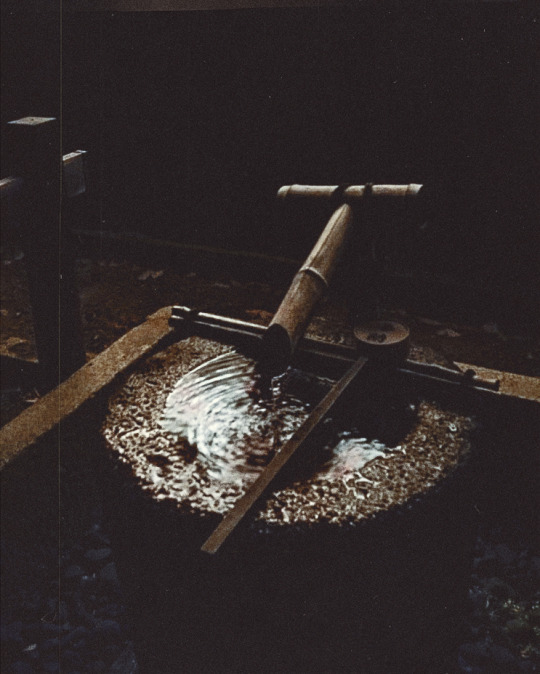
手水舎 Chouzuya
#chozuya#chouzuya#japan#temple#shrine#japanese#japanese style#water#shinto#photography#mobile photography#photographers on tumblr#original photographer#original photographers on tumblr#original photography blog#japan photos
4 notes
·
View notes
Photo
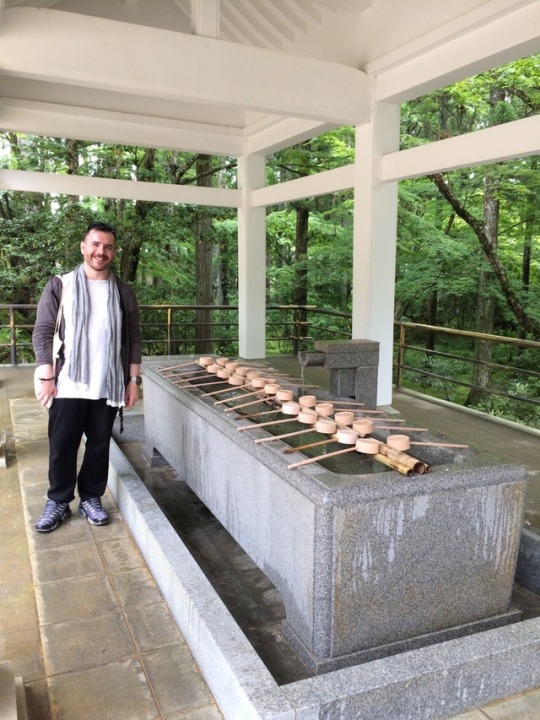
Before entering a religious complex (a temple or a shrine) worshippers need to purify themselves. I order to do this in front of many temples there is a purification pavilion called Chouzuya. Worshippers (and respectful visitors) can purify themselves in 4 steps: 1. Use a ladle to first clean your right hand with a little water, making sure the water falls on the ground and not in the basin. 2. change hand and clean the left one. 3. You then cup your right hand and pour a little water in it to rinse your mouth. Do not drink from the ladle. Spit the water discreetly on the ground, not the basin, covering your mouth with your hand. 4. Finally, hold the ladle vertically to let the rest of the content pour down the handle to purify it for the next person and place it back on the stand in the basin. If there is a towel hanging around the basin, feel free to use it to dry your hands.
1 note
·
View note
Text
Anatomy of a Shintō Shrine
Hello! Shinto shrines have a generally recognizable structure that may be confusing to some, so I will explain a typical shrine layout.
鳥居 Torii: Torii are the gates at the entrance of a shrine, sometimes followed by a path leading up to the shrine itself. It marks that the land behind it is holy. Torii can also be within shrine grounds. They can be of varying sizes and material, and usually are the materials’ natural color or crimson.

手水舎 Chouzuya: A Chouzuya is where you purify your hands and mouth. You use these hishaku scoops to scoop water from the basin.
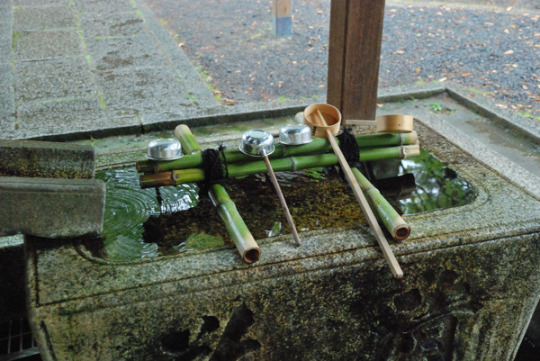
Pictured: Shimogoryo Jinja’s Chouzuya
There is a generally accepted specific procedure for using a Chozuya. Though purification is important in Shinto, this specific procedure and Chozuya in general are only for a shrine context. This sign is commonly seen at shrines:

Right to left, top to bottom it says to wash your left hand first, then your right, cup some water in your left hand and rinse out your mouth. Of course, you must not spit into the basin since people after you will use it too. I’ve often seen variations of this poster where worshippers are asked to lean the hishaku back so that the water cleans the handle, like so:
本殿 Honden: The honden is the main shrine building, where the kamisama is enshrined. It’s usually the largest on the shrine grounds. You cannot step foot within the building. Instead, you pray at the front. Some shrines have signs asking visitors not to take photos of the inside. Please respect those signs.

Pictured is Hiyoshi Taisha’s Higashi Hongu Honden.
お賽銭箱 Osaisen-bako: This is the box for monetary offerings. I grew up being told it was rude not to offer any money. Generally speaking, though, shrines are very dependent on money offerings for upkeep, maintenance etc. and more money is considered better. This is especially true for regional/rural shrines.

摂社 Sessha, and 末社 Massha: Smaller shrines to a different kamisama, which are affiliated with the shrine whose grounds they are on. They are usually there because the kamisama is in some way related to the gosaijin (enshrined kami) of the honden, such as being the child of the gosaijin. One shrine may have multiple sessha/massha. The distinction between sessha and massha is quite confusing and can vary by shrine as it was different pre-WWII.

Pictured: Umaji Isobe Jinja’s Sessha/Massha
授与所 Juyojo: Building where talismans/charms and fortunes are offered. Though shrines can be visited at any times, juyojo have hours of operation as they are staffed. You do not buy charms or ofuda, you offer money in exchange for the item or service.

Pictured: Samukawa Jinja’s juyojo
*This is a general post, so there are exceptions for the naming conventions.
90 notes
·
View notes
Text
Chapter 60 - Intrigue
AO3 - here
Fanfiction.net - here
It's Tuesday again! :D This chapter finally marks the end of this long ass day in the story. Dear lord it was long. XD But there were just so many character moments and other stuff happening. So yeah. :P
I made an edit to chapter 15 when Izuku first meets 1-A as Hiro. Commentor iluvstorys pointed out that Bakugou would have recognized Izuku's voice since that wasn't disguised. So I added a paragraph of his reaction when Izuku introduces himself. Thank you for pointing that out! :D
Alright, let's go!
Linktree to all the things!
End notes for the chapter are under the line.
And that concludes this long ass day! :D Izuku is still not sure whether to keep the recording or not, but has decided to keep it for now. That's a decision for future Izuku. For now, he really deserves some rest.
The Endeavor investigation has officially begun! Stain has laid witness to his 'training' and does not approve. Especially since it involves a child. I hope his reasons for not going for the immediate kill works for y'all. I want him to go for a more investigative route. ^____^
Uh oh! Overhaul has made an appearance! Though with this being a quirkless AU, personally I think it's kind of expected. Also, Izuku is a villain magnet so...
Fun Facts About Japan:
A souzu fountain ( 添水 , そうず ) is a type of shishi odoshi ( 鹿威し , ししおどし ) which is a Japanese device meant to frighten animals away from crops with the 'thunk' noise of the bamboo hitting the basin. Souzu are found in Japanese gardens typically. The original intent of them was to scare away animals but the audio and visual of the fountain became fused over time with the overall aesthetic and design of the garden.
There are also other types of fountains in Japanese culture. Chouzubachi ( 手水鉢 , ちょうずばち ) are found at Japanese temples, shrines, and gardens. They're usually made of stone with a ladle called hishaku ( 柄杓 , ひしゃく ) ready and water supplied by bamboo pipes called kakei ( かけい ). Tsukubai ( 蹲踞 , つくばい ) are another type of chouzubachi that are smaller and often found in tea gardens. Chouzubachi are washbasins that are used to wash one's hands before a tea ceremony or when visiting a temple or shrine. I've personally used both a chouzubachi when visiting temples and shrines and a tsukubai when attending a tea ceremony at a friend's house.
Before entering a temple/shrine or tea ceremony, visitors first visit the chouzuya ( 手水舎 , ちょうずしゃ ), which can also be read as temizuya ( てみずしゃ ), where the chouzubachi is contained. (Why the 'sha' is read as 'ya' in this instance I don't know.) There they perform a ceremonial purification rite called chouzu/temizu ( 手水 , ちょうず/てみず ) that means 'hand water'. Chouzu is a ritual where you use the provided ladle to first clean your left hand and then your right. Then you pour some water into your left hand to drink then spit into the fountain to cleanse/rinse your mouth. (at least I think you spit, but if any of you know otherwise let me know!) Then you wash your left hand again. With the remaining water in the ladle, you hold the handle with both hands and turn the ladle vertical to let the water run down the handle before putting it back.
Now I'd recommend not actually drinking the water mostly just because if you're not local there could be something in the water that could get you sick. Same with drinking local water anywhere when traveling though the tap water in Japan is ok to drink. But you can still go through the motions and the locals do appreciate seeing you try. Some will even show you how to do it! I had that happen and it was a fun cultural experience. ^____^
Alright! More subplots have begun! :D Coming up, we have the meeting with Nezu! Will Izuku and Hitoshi be offered to transfer? We'll find out next update! Please report any typos or weirdness and I'll see ya then! ^____^
#mha#bnha#quirkless au#support course#fanfic#blankcanvasfic#midoriya izuku#akaguro chizome#hero killer stain#chisaki kai#mha overhaul
2 notes
·
View notes
Text
High Speed Ch 2: Water
High Speed Ch 2: Water

Misagozaki Shrine is located on top of a small mountain, overlooking a tiny fishing harbor. About halfway up the stone stairway that lead to the shrine, there is a chouzuya next to the first torii, and all the way at the top of the stone stairway, just in front of the shrine’s courtyard is a second torii. The vast ocean could be seen sparkling in the sunlight just behind the shrine, the view from…
View On WordPress
90 notes
·
View notes
Text
Red-Haired Maiden | Past Life!AU
@hakoneonii
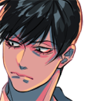
Ever since he left the army -- despite leaving behind his friends and somewhat-families -- Arakita felt like a reborn human. The pressure of taking orders from a master was no longer his, the wild and free life of a ronin suit him a lot more. Surely, he was not looked upon very fondly -- some people nudged him to approach Imaizumi-sama to work as his samurai -- but that was certainly not what a wildchild such as Yasutomo wanted.
Hydrangea were blooming in the late-summer, a sign that soon, the rainy days would follow, a relief from the humid heat that rested its head onto the shoulders of the country where the sun would rise. Cicadas breaking the silence of nature with their song, as he was stepping down the stony road near the shrine. He heard the prayers and songs filling the air -- what fools they were... praying to a God -- to Gods -- if they were as powerful as they were believed to be, how come someone as unfit as Midousuji would be the koshaku? Absolutely ridiculous.
In the midst of the prayers and singing, Yasutomo clearly heard the voice of a female; despite the fact that this must’ve been a very god-loving person, devoted and whatnot, her voice sounded like the blooming sakura trees would look in early spring; vivid, colourful, dainty, empowering and prideful.
As he stopped by the stairs that led up to the Tori, up to the shrine, he looked left and right for nobody to see him, ascending the stairs to the shrine, walking through the middle of the Tori like someone who did not fear the wrath and the pride of the Gods.
Walking over towards the building, he stood before the chouzuya, but refusing to clean himself, thus walking over to the toushouguu. As he saw the ema, he stood right there, taking a look at the wooden plaques that bore wishes and prayers of other people; money, fame, love, health, the usual. Without noticing that the prayers were over and done with -- and a female figure approaching him -- he spoke his mind, “About time someone was praying for more brain...” sounding just as bitter as usually.
#ic;#redhairedmaidenrp#PastLife!AU#hakoneonii#ooc; i linked the wiki for the architecture in case u need it
3 notes
·
View notes
Text
Imamiya Ebisu


Yesterday at Imamiya Ebisu shrine, I wrote and hung up my first e-ma!
I visited countless temples and shrines on my last trip, between Tokyo, Kamakura, and Kyoto, but I never wrote an e-ma (I just prayed and bought charms for my friends).
Imamiya Ebisu’s deity protects businesses, so make sure to wish for success of your or someone else’s business.
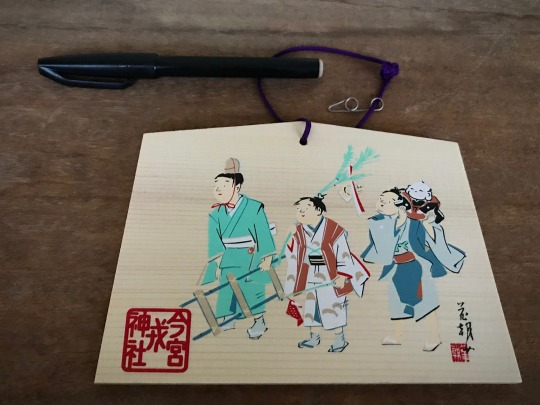
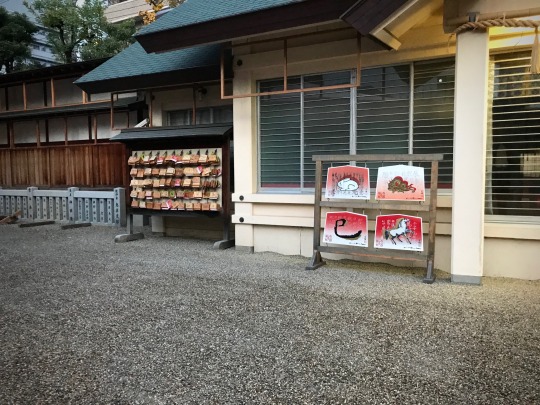
E-ma are wooden boards on which you write a prayer or wish, and hang it up. On a certain date, they are all taken down and burned at a ritual/event. Mine cost 1100 yen, and the money goes towards upkeep of the shrine. You need to buy it at the shrine office, where charms and amulets are sold - e-ma seem not to be displayed so you need to ask for it.
Another non-obvious item you can get is an omikuji. This is a paper fortune. The most important to know is that if you get a bad fortune, tie it onto a branch so you don’t take the curse with you! I haven’t gotten an omikuji yet because I’m not confident I’d be able to interpret it correctly 😅
Don’t forget to rinse your hands at the chouzuya before doing anything - there is a good shrine and temple etiquette guide here.
0 notes
Text
四目神攻略 - 第二章:洗手舍

Yotsumegami is a mobile game made by SEEC.
This game is currently in Japanese and Mandarin Chinese only.
Here I will put up a walkthrough to the Chinese version of the game.
English translations below!
Do send me a message if you’re stuck on any parts :)
——
消耗精神力:20
1. 与【忌子】来到了《洗手舍》,发现没有水和勺子
2. 调查《洗手舍》屋顶,发现一样东西,但拿不到
3. 移动到《参道》,捡起路旁边的《木棒》
4. 看看守”门“的狛犬 ——
左边:【水妖,问吾三遍】
右边:没写什么
5. 回到《洗手舍》
6. 用《木棒》拿舍顶上的东西, 以此将两物混合,得到《勺子》
7. 调查《洗手舍》左边,写着净身的方法
8. 调查《洗手舍》中间,按狛犬,让两个面对对方
9. 用勺子挑水净身 —— 先洗左手,然后洗右手,再用左手盛水洗口部,漱口后洗左手,最后把勺子放直,清洗它
—— 【第二章:完】——
—— ENGLISH ——
Chapter 2: Chouzuya (A small sidehouse for cleansing the body before entering a shrine)
Chapter Summary:
You find out that the young man is named Imigo 【忌子】. Imigo, at some point, tells you that you are not to touch him, or there will be dire consequences. Confused, you follow his instruction. You are also told that you smell, at which you make a small fuss. You are asked to cleanse yourself before entering the shrine, but there is no water or any scoops for you to use!
Investigate the area to get items and clues, and use them to help you start the cleansing process.
——
Stamina required: 20
1. Arrive at the sidehouse with Imigo and realise that there is no water or a scoop for you to use!
2. Investigate the sidehouse’s rooftop. You will see a WOODEN BOWL but have no way to get it. (You cannot touch Imigo, so there is no way for either of you to stand on the other person.)
3. Move to the “main road” (It’s a path approaching a shrine.) Investigate the left side of the path and you will obtain a WOODEN STICK.
4. Look at the “Guard Dogs” on either side of the path ——
Left: Below the dog statue is a line:【Water Demon, ask me thrice】
Right: Nothing interesting here
Note that the Guard Dogs are facing each other.
5. Return to the sidehouse.
6. Open your inventory, and use the WOODEN STICK to get the WOODEN BOWL from the rooftop. Combine those 2 items (click on the stick to open it so that it shows up on screen, then tap on the bowl once, and then once more on the stick.) and you have a scoop!
7. Investigate the left pillar of the sidehouse; there is a poster with instructions on how to correctly cleanse yourself.
8. Investigate the middle of the sidehouse where there are 2 statues. Remember the positions of the Guard Dogs on Part 6, and turn both statues to face each other. You now have water!
9. Use the scoop you have made to start the cleansing process! ——
- Wash your LEFT HAND (先洗左手)
- Wash your RIGHT HAND (然后洗右手)
- Use your LEFT HAND , SCOOP WATER AND WASH THE MOUTH (再用左手盛水洗口部)
- Wash your LEFT HAND again (漱口后洗左手)
- Put the scoop in an UPRIGHT POSITION AND WASH IT (最后把勺子放直,清洗它)
—— 【Chapter 2 End】——
1 note
·
View note
Text
Story from a former Shinto priest: About the wedding ceremony.
Story from a former Shinto priest: About the wedding ceremony.
*This is not a secret story.
In general terms, Oharai are rituals of purification in Shinto.
They purify sins and foulness, and are not about ghosts or spirit possession.
For example, foulness happens by unintentionally killing mosquitoes or harming others, or telling a white lie.
Chouzuya is the area of a shrine where you wash your hands and rinse your mouth. It is an abbreviated act of…
View On WordPress
0 notes
Photo

It’s a Japanese ladle of CHOUZUYA at shrine . . https://www.pond5.com/artist/tokyovisionaryroom . #pond5 #stockphoto #stockfootage #photography #footage #japanese #japanesephotography #japaneseculture #tokyo🇯🇵 #tokyolife #japanlife #japanlifestyle #lovejapan #japanlover #nihon #ig_japan #travelgram #shrine #temple #japaneseshrine (赤城神社)
#footage#japanlife#pond5#ig_japan#shrine#japanesephotography#stockphoto#photography#nihon#temple#japanese#lovejapan#japanlover#travelgram#japaneseculture#tokyo🇯🇵#stockfootage#japanlifestyle#japaneseshrine#tokyolife
0 notes
Photo

和傘 Wagasa
#japanese#japan#umbrella#temple#chozuya#Chouzuya#shrine#purple#flowers#pink#water#photography#photographer#photographers on tumblr#original photography blog#original photographers on tumblr#original photographer#japan photos
1 note
·
View note
Photo
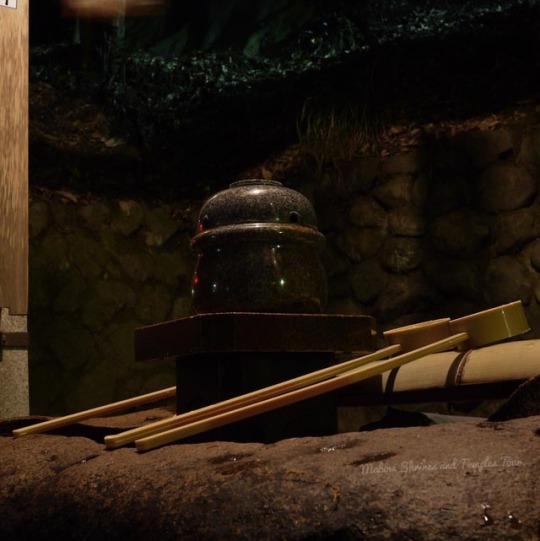
伏見稲荷大社 稲荷Night ◾️手水舎◾️ . . . . . 二股の千本鳥居⛩⛩を抜けてすぐの手水舎 水が出てるところは玉?鈴? まーるいのでした。 二の鳥居の所の手水舎で清めたのでここでは写真撮影のみです👏🏻 . . . . . 〜Fushimiinari shrine 〜 General headquarters in Inarijinja where you say that about 30,000 companies are in the whole country ■Chouzuya■ The chozuya which passes through one thousand torii of a fork, and is immediately . . . . . #いつもは1人で撮影 #たまには誰かとワイワイ撮影したい #撮影同行して下さる方募集中 #京都 #伏見稲荷大社 #伏見稲荷 #神社 #神社仏閣 #寺社 #神社巡り #神社めぐり #kyoto #japan #shrine #fushimiinari #special_zipangu_ #retro_japan_ #special_spot_ #Lovers_Nippon #team_jp_西 #PHOS_JAPAN #japan_of_insta #写真好きな人と繋がりたい #japan_night_view #tripgramjp #手水舎 (伏見稲荷大社)
#神社巡り#手水舎#japan_night_view#kyoto#写真好きな人と繋がりたい#phos_japan#team_jp_西#神社仏閣#寺社#fushimiinari#special_spot_#京都#伏見稲荷大社#shrine#伏見稲荷#japan#いつもは1人で撮影#japan_of_insta#撮影同行して下さる方募集中#retro_japan_#tripgramjp#たまには誰かとワイワイ撮影したい#lovers_nippon#神社#神社めぐり#special_zipangu_
0 notes
Photo
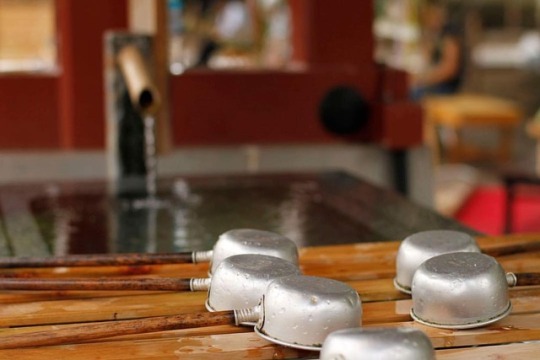
CHOUZUYA in the shrine. If you wash your hands🙌 at there, the first is left hand✋️, next is right🤚. Please rinse your mouth after that. Don't drink 🙅🏻♂️😁😁 . https://www.pond5.com/artist/tokyovisionaryroom . #pond5 #stockphoto #stockfootage #photography #footage #japanese #japanesephotography #japaneseculture #tokyo🇯🇵 #tokyolife #japanlife #japanlifestyle #lovejapan #japanlover #nihon #travelphotographer #japanphoto #tokyophotography #ig_japan #worldtraveler #instajapan #instatravel #instatokyo #wanderlust #visualsoflife #travelgram #artofvisuals #instagood #shrine #temple (Asakusa-jinja Shrine)
#stockfootage#tokyophotography#ig_japan#japanphoto#instatravel#stockphoto#japanlife#japanlover#visualsoflife#travelphotographer#japanese#temple#tokyolife#tokyo🇯🇵#travelgram#worldtraveler#instagood#nihon#japaneseculture#pond5#footage#instajapan#lovejapan#japanesephotography#artofvisuals#japanlifestyle#photography#wanderlust#instatokyo#shrine
0 notes
